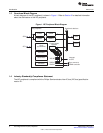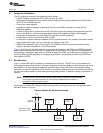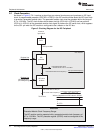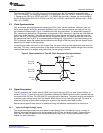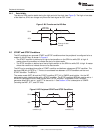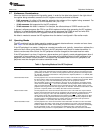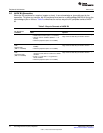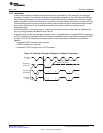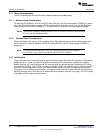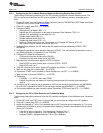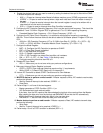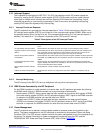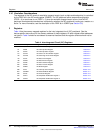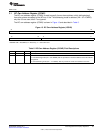
Peripheral Architecture
www.ti.com
2.9 NACK Bit Generation
When the I2C peripheral is a receiver (master or slave), it can acknowledge or ignore bits sent by the
transmitter. To ignore any new bits, the I2C peripheral must send a no-acknowledge (NACK) bit during the
acknowledge cycle on the bus. Table 2 summarizes the various ways the I2C peripheral sends a NACK
bit.
Table 2. Ways to Generate a NACK Bit
NACK Bit Generation
I2C Peripheral
Condition Basic Optional
Slave-receiver mode Set the NACKMOD bit of ICMDR before the rising
• Disable data transfers (STT = 0 in ICSTR).
edge of the last data bit you intend to receive.
• Allow an overrun condition (RSFULL = 1 in
ICSTR).
• Reset the peripheral (IRS = 0 in ICMDR)
.
Master-receiver mode Set the NACKMOD bit of ICMDR before the rising
• Generate a STOP condition (STOP = 1 in
AND edge of the last data bit you intend to receive.
ICMDR).
Repeat mode
• Reset the peripheral (IRS = 0 in ICMDR).
(RM = 1 in ICMDR)
Master-receiver mode Set the NACKMOD bit of ICMDR before the rising
• If STP = 1 in ICMDR, allow the internal data
AND edge of the last data bit you intend to receive.
counter to count down to 0 and force a STOP
Nonrepeat mode
condition.
(RM = 0 in ICMDR)
• If STP = 0, make STP = 1 to generate a
STOP condition.
• Reset the peripheral (IRS = 0 in ICMDR).
16
Inter-Integrated Circuit (I2C) Peripheral SPRUEN0D–March 2011
Submit Documentation Feedback
© 2011, Texas Instruments Incorporated



